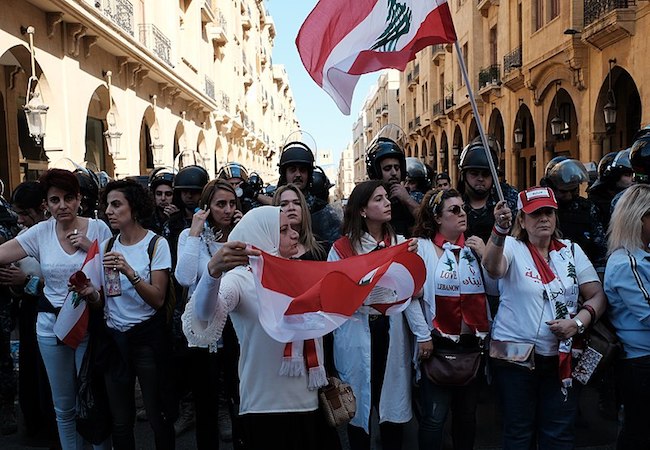Lebanon’s revolutionary wins amid regional losses: Iran in the Arab Spring 2.0

By Jasmin Lilian Diab
In a little over a month and a half now, anti-government protests against corruption, economic incompetence, as well as basic standards of living have erupted across both Iraq and Lebanon in what is being referred to as the Arab Spring’s second wave, or the Arab Spring 2.0. In both countries, the demonstrations, which further spread into the heart of many predominantly Shiite areas, have revealed that Iran’s system of “influence” in the region is dwindling. Many even argue that it is the beginning of its end. For the Shiite community in Lebanon, Iran and its allies have failed to translate political victories into tangible socio-economic sustainability and continuity. Iran’s resistance rhetoric was quite simply unable to feed the bellies of its supporters amid feeding their political egos.
When the wave of uprisings eventually dubbed the “Arab Spring” erupted across the Middle East just eight years ago, Iran not only commended these revolutions as an Islamic “awakening”, but also outwardly expressed their support of these uprisings vocally. This indeed, with the notable exception of Syria where Iran saw the demonstrations as a major blow to its relationship with its “sole regional ally”. And this is where it gets interesting, because Lebanon is seen through a similar lens.
This year the Middle East has arguably been experiencing what many scholars are dubbing the “Arab Spring 2.0” (an entirely different debate outside the scope of this article). Anti-governmental demonstrations have swept Algeria, Iraq, Lebanon, and Sudan – all countries which were interpreted to have “withstood” the test of the first wave of Arab uprisings in 2011 without it spilling over into their borders. So what is different this time? Simple: It is that Iran, according to Azodi and Cafiero (2019), is “not welcoming the mobilization of anti-government protestors demanding fundamental reforms in countries where the Islamic Republic has spent many years investing its political and economic capital”.[1]
The unrest in Lebanon has been a very huge obstacle in the face of Iranian interests, as Lebanon continues to constitute an indispensible pillar of Iran’s geopolitical standing in the region, its sphere of influence, and arguably, its shifting existential crisis. For if Iran loses Lebanon, and then loses Iraq, then who are its allies in the region? And who will carry the “cause” at the heart of its regional power?
Iran’s response to the controversial “Arab Spring 2.0” has been fundamentally different than its aforementioned stance toward the 2011 uprisings. Toward the end of October 2019, just shy of the Lebanese Revolution’s two-week anniversary, Supreme Leader Ayatollah Ali Khamenei warned that “arrogant powers and western intelligence services are creating chaos in some of our neighboring regional countries with money from some reactionary countries in the region”.
As Iran has invested its strategic interests in a significant faction of Lebanon’s political leadership being Iran-friendly (and Iran-backed), this factional Lebanese political support remains weak in combating the weight and power of the American-Israeli-Saudi Arabian agenda for the country. The stability of Lebanon presently, as well as Hezbollah remaining officially politically represented and legitimized in Lebanon’s government, is crucial to Iran’s security interests, its political sustainability, and its sphere of influence in the region.
Infamous Lebanese militant group and political party Hezbollah, which is Iran’s most valuable asset in the region, has been historically quite effective in assisting Iran’s geopolitical resilience in the face of Western and other regional competitors. This value put on display during the 2006 war with Israel, as well as amid Hezbollah’s intervention in the Syrian civil war to this day. With so many Lebanese players not playing for Lebanon’s team, where does the revolution stand in the areas of effectiveness if it continues to put more strains on the Lebanese themselves? As Lebanese are continuously pivoted against other Lebanese with “external agendas”, who is the real enemy here?
References:
[1] Azodi, S. & Cafiero, G. (2019), Why Iran Wants Lebanon and Iraq Uprisings to Fail, Atlantic Council, Retrieve at: https://www.atlanticcouncil.org/blogs/iransource/why-iran-wants-the-lebanon-and-iraq-uprisings-to-fade/
Jasmin Lilian Diab, ABD is a Research Associate, American University of Beirut







